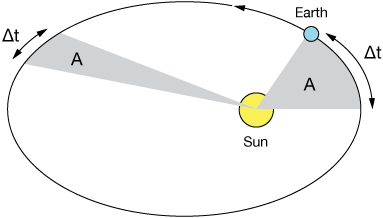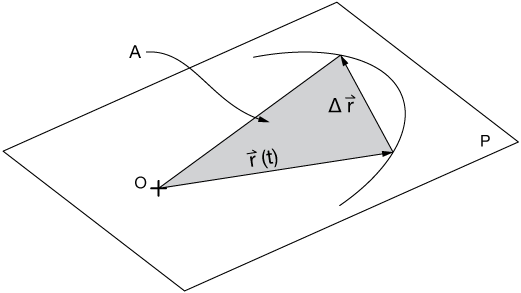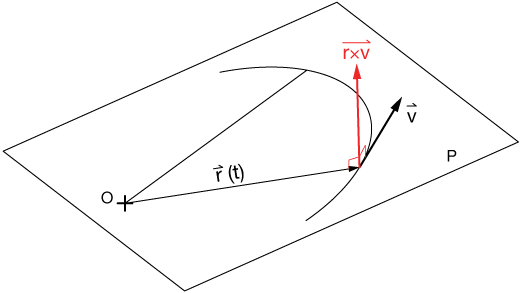This section uses the example of Kepler's 3rd law of planetary motion to illustrate the usefulness of a vector & parametric representation of curves in space, or in a plane.
Kepler's laws
Johannes Kepler (1571-1630), building on the detailed observations of his predecessor astronomers, derived three laws of planetary motion that were later expanded upon by Isaac Newton. They are:
- Orbits are elliptical, with the body being orbited at one focus of the ellipse and the body orbiting traveling around it.
- The line between the orbiting planet and the body being orbited sweeps out equal planar areas in equal time.
- The squares of the orbital periods of the planets are directly proportional to the cubes of the semi-major axes of their orbits.
Here we'll focus on the second law, and try to rationalize it using vectors.
Here's a diagram (not to scale) of Earth's orbit around the Sun. Earth's orbit is very nearly circular, but this ellipse has been elongated (more "eccentric") just for illustration purposes.

The Sun sits at one focus of the ellipse and Earth orbits around the ellipse. By the way, Earth is closest to the Sun in the winter of the northern hemisphere — think about that. Kepler's 2nd law says that as Earth orbits, equal areas are "swept out" by the line between the planet and the sun in equal time, $\Delta t$. That means that the speed of the planet is constantly changing as it orbits. Now let's analyze it.
A quick example
Here is the basic idea. Part of the elliptical orbit, lying in plane $P$, is shown. The vector $\vec r(t)$ from the origin ($O$) to the ellipse traces the trajectory, and we're interested in how it moves. The vector $\Delta \vec r$ shows that change. Of course, we'll want to decrease the length of that to zero as we bring in our calculus ideas to get an exact trajectory.

Here's the same diagram with that area drawn in.

Now the area of that triangle is half of the area of the parallelogram we'd make using vectors $\vec r(t)$ and $\Delta \vec r$. If we recall that the area of such a parallelogram is the cross product between the vectors that form it, then the area of our triangle is
$$\frac{1}{2} | \vec r \times \vec \Delta r|$$
Because distance is speed multiplied by time, $d = st$, we have
$$\Delta \vec r \approx \vec v \Delta t$$
So we have
$$ \begin{align} \text{Area} &= \frac{1}{2} | \vec r \times \Delta \vec r| \\[5pt] &= \frac{1}{2} | \vec r \times \vec v| \Delta t \end{align}$$
This says that the area is proportional to $\Delta t$, so according to Kepler's observations, the cross product $|\vec r \times \vec v|$ must be constant.
Now let's take a look at that trajectory in the plane now that we've introduced a velocity vector:

The cross product $|\vec r \times \vec v|$ is perpendicular to the plane of the trajectory.
Now Kepler's 2nd law says that $|\vec r \times \vec v|$ is constant, which means that its derivative is equal to zero:
$$\frac{d}{dt} |\vec r \times \vec v| = \vec 0$$
To do this derivative, we just use the product rule of derivatives,
$$ \begin{align} \require{cancel} \frac{d}{dt} |\vec r \times \vec v| &= \frac{d\vec r}{dt} \times \vec v + \vec r \times \frac{d \vec v}{dt} \\[5pt] &= \vec v \times \vec v + \vec r \times \vec a = 0 \tag{1} \\[5pt] &= \vec r \times \vec a = 0 \end{align}$$
In orbital mechanics, that's a pretty significant result. Think about it: If $\vec r \times \vec a = 0$, then the parallelogram defined by that cross product has an area of zero, meaning that $\vec r$ and $\vec a$ must be in the same direction. That is to say that the force that causes the acceleration — gravity — is on a line between the two bodies (Sun and Earth in this case).
We now know (actually since Newton's work) that the only force keeping Earth in orbit around the Sun — or the moon in orbit around Earth, and so on ... — is the gravitational force, which is a centripetal ("center-seeking") force. It was once thought that for, let's say, the moon to orbit Earth, a force needed to be applied behind the moon tangent to the orbit. One theory was that invisible angels were pushing it around. Now we understand that it's a combination of the moon's own inertia coupled with this cetripetal force due to gravity.

![]()
xaktly.com by Dr. Jeff Cruzan is licensed under a Creative Commons Attribution-NonCommercial-ShareAlike 3.0 Unported License. © 2016, Jeff Cruzan. All text and images on this website not specifically attributed to another source were created by me and I reserve all rights as to their use. Any opinions expressed on this website are entirely mine, and do not necessarily reflect the views of any of my employers. Please feel free to send any questions or comments to jeff.cruzan@verizon.net.

